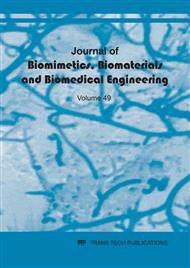[1]
J. L. Frode, S. Lee, The use of high-density polyethylene implants in facial deformities, Arch Otolaryngol Head Neck Surg. 124 (1998)1219-1223.
DOI: 10.1001/archotol.124.11.1219
Google Scholar
[2]
N. M. Whear, R. R. Cousley, C. Liew, D. Henderson, Post-operative infection of Proplast facial implants, Br. J. Oral Maxillofac. Surg. 31 (1993) 292-295.
DOI: 10.1016/0266-4356(93)90062-2
Google Scholar
[3]
S.M. Best, A.E. Porter, E.S. Thian, J. Huang, Bioceramics: Past, present and for the future, Journal of the European Ceramic Society. 28 (2008) 1319-1327.
DOI: 10.1016/j.jeurceramsoc.2007.12.001
Google Scholar
[4]
D. L. Hoexter, Bone regeneration graft materials, J. Oral Implantol. 28 (2002) 290-294.
Google Scholar
[5]
D. W. Hutmacher, Scaffold in Tissue Engineering Bone and cartilage, Biomaterials, 21 (2000) 2529-2543.
DOI: 10.1016/s0142-9612(00)00121-6
Google Scholar
[6]
V. Campana, G. Milano, E. Pagano, M. Barba, C. Cicione, G. Salonna, W. Lattanzi, G. Logroscino, Bone substitutes in orthopaedic surgery: from basic science to clinical practice, J Mater Sci Mater Med. 25 (2014) 2445–2461.
DOI: 10.1007/s10856-014-5240-2
Google Scholar
[7]
S. K. Nandi, B. Kundu, S. K. Ghosh, D. K. De, D. Basu, Efficacy of nano-hydroxyapatite prepared by an aqueous solution combustion technique in healing bone defects of goat, J Vet Sci. 9 (2008) 183–191.
DOI: 10.4142/jvs.2008.9.2.183
Google Scholar
[8]
J. M. Spivak, A. Hasharoni, Use of hydroxyapatite in spine surgery, Eur Spine J. 10 (2001) S197–S204.
DOI: 10.1007/s005860100286
Google Scholar
[9]
T. Koshino, T. Murase, T. Takagi, T. Saito, New bone formation around porous hydroxyapatite wedge implanted in opening wedge high tibial osteotomy in patients with osteoarthritis, Biomaterials. 22 (2001) 1579–1582.
DOI: 10.1016/s0142-9612(00)00318-5
Google Scholar
[10]
M. Chazono, T. Tanaka, H. Komaki, K. Fujii, Bone formation and bioresorption after implantation of injectable beta-tricalcium phosphate granules-hyaluronate complex in rabbit bone defects, J. Biomed. Mater. Res. A 70 (2004) 542–549.
DOI: 10.1002/jbm.a.30094
Google Scholar
[11]
J. M. Wozney, V. Rosen, Bone morphogenetic protein and bone morphogenetic protein gene family in bone formation and repair, Clin. Orthop. 346 (1998) 26-37.
DOI: 10.1097/00003086-199801000-00006
Google Scholar
[12]
K. S. Lee, J. S. Chang, J. H. Kim, et al., The role of osteoclast in resorption of hydroxyapatite and β-tricalcium phosphate coating layer, Key Eng. Mater. 396–398 (2009) 81–84.
DOI: 10.4028/www.scientific.net/kem.396-398.81
Google Scholar
[13]
L. Galois, D. Mainard, Bone ingrowth into two porous ceramics with different pore sizes: an experimental study, Acta. Orthop. Belg. 70 (2004) 598–603.
Google Scholar
[14]
S. Cavalu, G. Damian, M. Dansoreanu, EPR study of non-covalent spin labeled serum albumin and hemoglobin, Biophysical Chemistry 99 (2002) 181–188.
DOI: 10.1016/s0301-4622(02)00182-5
Google Scholar
[15]
S. CõÃntaÄ-PõÃnzaru, S. Cavalu, N. Leopold, Petry R.and Kiefer W. Raman and surface-enhanced Raman spectroscopy of tempyo spin labelled ovalbumin, Journal of Molecular Structure 565-566 (2001) 225-229.
DOI: 10.1016/s0022-2860(00)00930-3
Google Scholar
[16]
L. Yin, H. X. Peng, S. Dhara, L. Yang, B. Su, Natural additives in protein coagulation c asting process for improved microstructural controllability of cellular ceramics, Composites: Part B. 40 (2009) 638–644.
DOI: 10.1016/j.compositesb.2009.04.016
Google Scholar
[17]
W. A. Hussain, S. N. Rafiq, Mechanical properties of carrot fiber- epoxy composite, J. Baghdad Sci. 9 (2012) 335-340.
Google Scholar
[18]
T. Theophile, Infrared Spectroscopy: Materials Science, Engineering and Technology, InTech, Janeza Trdine 9, 51000 Rijeka, Croatia, (2012).
Google Scholar
[19]
I. Sopyana,, M. Melb, S. Rameshc, K. A. Khalid, Porous hydroxyapatite for artificial bone applications, Science and Technology of Advanced Materials 8 (2007) 116–123.
Google Scholar
[20]
A. R. Fariza, A. Zuraida, I. Sopyan, Egg Yolk as Pore Creating Agent to Produce Porous Tri-Calcium Phosphate for Bone Implant Application, Adv. Mater. Research 264-265 (2011) 760-764.
DOI: 10.4028/www.scientific.net/amr.264-265.760
Google Scholar
[21]
T. Tosiriwatanapong, W. Singhatanadgit, Zirconia-Based Biomaterials for Hard Tissue Reconstruction, Bone and Tissue Regeneration 9 (2018) 1–9.
DOI: 10.1177/1179061x18767886
Google Scholar
[22]
E. Gregorová, Z. Živcová, W. Pabst, A. Kunertová, Starch-Processed Ceramics with Porosity or Pore Size Gradients, J. Eur. Ceram. Soc. 29 (2009) 347–353.
Google Scholar
[23]
V. Jokanović, B. Čolović, D. Marković, S. Živković, Bioactive Glasses in Bone Tissue Engineering, Serbian Dental Journal 62 (2015) 71-79.
DOI: 10.1515/sdj-2015-0008
Google Scholar
[24]
V. Eldere, Multicentre surveillance of Pseudomonas aeruginosa susceptibility patterns in nosocomial infections, J. Antimicrobial Chemotherapy 51 (2003) 347–352.
DOI: 10.1093/jac/dkg102
Google Scholar
[25]
M. J. Buehler, Y. C. Yung, Deformation and failure of protein materials in extreme conditions and disease, Nature Materials 8 (2009) 175-188.
DOI: 10.1038/nmat2387
Google Scholar
[26]
K. Yamane, Y. Doi, K. Yokoyama, T. Yagi, H. Kurokawa, N. Shibata, K. Shibayama, H. Kato, Y. Arakawa, Genetic environments of the rmtA gene in Pseudomonas aeruginosa clinical isolates, Antimicrobial Agents and Chemother. 48 (2004) 2069–(2074).
DOI: 10.1128/aac.48.6.2069-2074.2004
Google Scholar
[27]
S. K. Mazmanian, H. Ton-That, O. Schneewind, Sortase-catalysed anchoring of surface proteins to the cell wall of Staphylococcu saureus, Molecular Microbiology 40 (2001) 1049-1057.
DOI: 10.1046/j.1365-2958.2001.02411.x
Google Scholar
[28]
J. P. Euzéby, List of Bacterial Names with Standing in Nomenclature: a folder available on the Internet, Int. J. Systematic Bacteriology 47 (1997) 590-592.
DOI: 10.1099/00207713-47-2-590
Google Scholar
[29]
W. A. Hussain, E. M. Hadi, M. M. Ismail, L. H. Alwan, Preparation of Household Water Filter. Journal of applied science and engineering 23 (2020) 61-68.
Google Scholar
[30]
G. Lopéz-Lopéz, A. Pascual, E. J. Perea, Effect of plastic catheter material on bacterial adherence and viability, J. Med. Microbiol. 34 (1991) 349-353.
DOI: 10.1099/00222615-34-6-349
Google Scholar
[31]
K. Tegmark, A. Karlsson, S. Arvidson, Identification and characterization of SarH1, a new global regulator of virulence gene expression in Staphylococcus aureus, Molecular microbiology 37 (2000) 398-409.
DOI: 10.1046/j.1365-2958.2000.02003.x
Google Scholar
[32]
H. D. Espinosa, J. E. Rim, F. Barthelat, M. J. Buehler, Merger of Structure and Material in Nacre and Bone - Perspectives on de novo Biomimetic Materials, Pro. Mater. Sci. 54 (2009) 1059–1100.
DOI: 10.1016/j.pmatsci.2009.05.001
Google Scholar
[33]
W. R. Walsh, R. A. Oliver, C. Christou, V. Lovric, E. R. Walsh, G. R. Prado, et al., Critical Size Bone Defect Healing Using Collagen–Calcium Phosphate Bone Graft Materials, PLoS ONE. 12 (2017) e0168883.
DOI: 10.1371/journal.pone.0168883
Google Scholar
[34]
T. A. Surovell, M. C. Stiner, Standardizing Infra-red Measures of Bone Mineral Crystallinity: an Experimental Approach, J. Archaeological Sci. 28 (2001) 633–642.
DOI: 10.1006/jasc.2000.0633
Google Scholar


